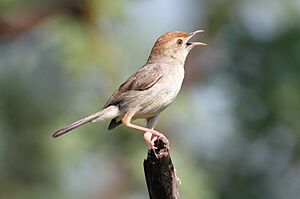Neddicky facts for kids
Quick facts for kids Neddicky |
|
|---|---|
 |
|
| A Neddicky in Pilanesberg, South Africa | |
| Conservation status | |
| Scientific classification | |
| Synonyms | |
|
Cisticola fulvicapillus |
The Neddicky, also known as the Piping Cisticola (Cisticola fulvicapilla), is a small bird. It belongs to a group of birds called passerines. This bird is found in Africa, mainly south of the equator. It likes to live in open woodlands and bushy areas in southern Africa. The name "Neddicky" comes from the Afrikaans language.
Contents
Where the Neddicky Lives
The Neddicky lives in many parts of Africa. You can find it from countries like Gabon and Tanzania all the way south to the Cape in South Africa. These birds usually stay in the same area all year round.
Neddicky's Home
Neddickies are common birds. They like open woodlands, including savannahs with trees. They also live in open areas where non-native trees have been planted. They do not like thick forests or very dense woods.
About the Neddicky
The Neddicky is a small bird, about 11 centimeters (4.3 inches) long. It is a dull brown color and likes to sing a lot. Its tail is not as short as some other cisticola birds.
This bird has a reddish-brown cap on its head. Its back is plain brown. The feathers on its belly are a light brown color, which is darker on its chest. The Neddicky has a short, straight brown beak. Its feet and legs are a pinkish-brown color. It has light brown eyes.
Male and female Neddickies look very similar. However, young Neddickies are a bit more yellow in color.
Some Neddickies, found in southern South Africa, have grey faces and bellies. Their backs are also greyish-brown. These greyish birds look quite different from most other cisticolas.
Neddicky Calls
The Neddicky makes a simple, loud, and repeated sound that sounds like weep weep weep. When it senses danger, its alarm call is a loud clicking sound. It sounds like a fingernail being run across the teeth of a comb.
Neddicky Behavior
The Neddicky builds a round nest. It makes the nest from dry grass, cobwebs, and soft plant material. The nest has an opening on the side. These birds usually place their nests low down in a thorny bush or in thick grass. In South Africa, Neddickies mostly build their nests and lay eggs from September to March.
You will usually see Neddickies alone or in pairs. They often flit around in bushes or in the grass near the bottom of a tree. They are looking for small insects to eat.
Conservation Status
The Neddicky is a common bird species. It lives across a very large area, estimated to be about 4.1 million square kilometers (1.6 million square miles). Scientists believe there are many Neddickies, and their numbers are not decreasing quickly. Because of this, the IUCN Red List considers the Neddicky to be a species of "least concern." This means it is not currently at risk of disappearing.
Images for kids




